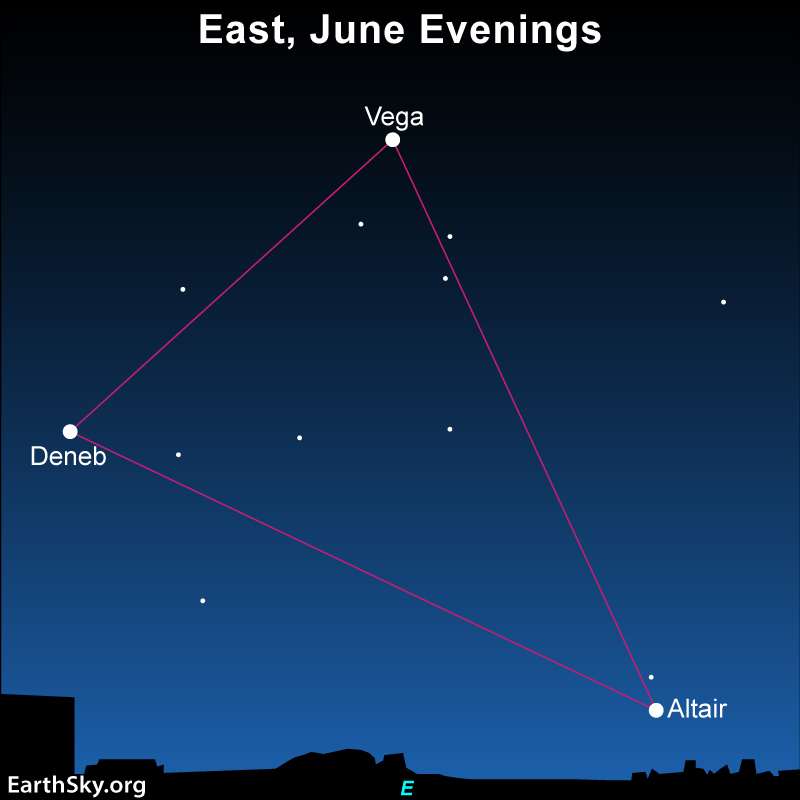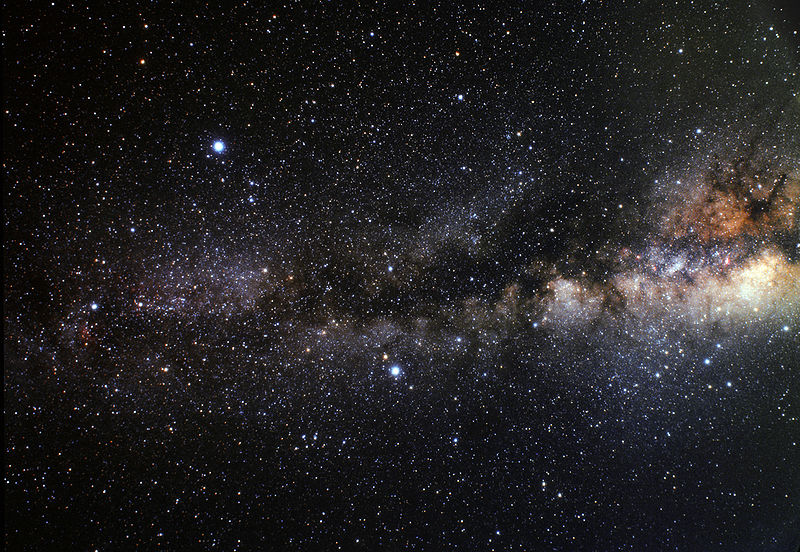
Summertime is Summer Triangle time
During the summertime in the Northern Hemisphere, the days are long. The sun is high in the midday sky. And the summer sky is with us, too. Watch for the famous Summer Triangle, now ascending in the eastern sky on these late June and July evenings.
The Summer Triangle isn’t a constellation. It’s an asterism, or noticeable pattern of stars. This pattern consists of three bright stars in three separate constellations – Deneb in the constellation Cygnus the Swan, Vega in the constellation Lyra the Harp, and Altair in the constellation Aquila the Eagle.
Learn to recognize the Summer Triangle asterism now, and you can watch it all summer as it shifts higher in the east, then finally appears high overhead in the late northern summer and early northern autumn sky.
How to find the Summer Triangle
As night falls in June or July, look east for a sparkling blue-white star. That will be Vega, in Lyra. Reigning at the apex of the celebrated Summer Triangle, Vega is also the brightest of the Summer Triangle’s three stars, which are all bright enough to be seen from many light-polluted cities.
Look to the lower right of Vega to locate the Summer Triangle’s second brightest star. That’s Altair, the brightest star in the constellation Aquila the Eagle. A ruler (12 inches, 30 cm) held at arm’s length fills the gap between these two stars.
Look to the lower left of Vega for another bright star: Deneb, the brightest in the constellation Cygnus the Swan and the third brightest in the Summer Triangle. An outstretched hand at arm’s length approximates the distance from Vega to Deneb.
It’s difficult to convey the huge size of the Summer Triangle. But you’ll see it. These three bright stars – Vega, Deneb and Altair – will become summertime favorites.


Summer Triangle as a road map to the Milky Way
If you’re lucky enough to be under a dark starry sky on a moonless night, you’ll see the great swath of stars passing between the Summer Triangle’s Vega and Altair. The star Deneb bobs in the middle of this river of stars, which arcs across dark summer skies. This sky river is, of course, the edgewise view into our own Milky Way galaxy. Every star you see with the unaided eye is a member of the Milky Way. And at this time of year, we can see clearly into the galaxy’s flat disk, where most of the stars congregate. By August and September, we will have a good view toward the galaxy’s center.
Once you master the Summer Triangle, you can always locate the Milky Way on a clear, dark night. How about making the most of a dark summer night to explore this band of stars, this starlit boulevard with its celestial delights? Use binoculars to reveal the gossamer beauty of the haunting nebulae and bejeweled star clusters along this starlit trail.

Nature’s seasonal calendar
Also, the Summer Triangle serves as a stellar calendar, marking the seasons. So when the stars of the Summer Triangle light up the eastern twilight dusk in middle to late June, it’s a sure sign of the change of seasons, of spring giving way to summer. However, when the Summer Triangle is high in the south to overhead at dusk and early evening, the Summer Triangle’s change of position indicates that summer has ebbed into fall.
A word about asterisms
As we mentioned above, asterisms aren’t constellations; they’re just patterns on the sky’s dome. Constellations generally come to us from ancient times. In the 1930s, the International Astronomical Union officially drew the boundaries of the 88 constellations we recognize today.
Meanwhile, you can make up and name your own asterisms, in much the same way you can recognize shapes in puffy clouds on a summer day.
Of course, some asterisms are so obvious that they’re recognized around the world. And the Summer Triangle is one of these.
Bottom line: On June and July evenings, you’ll find the Summer Triangle in the east at nightfall. It swings high overhead after midnight and sits in the west at daybreak.
The post Summer Triangle: Star pattern of the season first appeared on EarthSky.
from EarthSky https://ift.tt/Nzq2f7b

Summertime is Summer Triangle time
During the summertime in the Northern Hemisphere, the days are long. The sun is high in the midday sky. And the summer sky is with us, too. Watch for the famous Summer Triangle, now ascending in the eastern sky on these late June and July evenings.
The Summer Triangle isn’t a constellation. It’s an asterism, or noticeable pattern of stars. This pattern consists of three bright stars in three separate constellations – Deneb in the constellation Cygnus the Swan, Vega in the constellation Lyra the Harp, and Altair in the constellation Aquila the Eagle.
Learn to recognize the Summer Triangle asterism now, and you can watch it all summer as it shifts higher in the east, then finally appears high overhead in the late northern summer and early northern autumn sky.
How to find the Summer Triangle
As night falls in June or July, look east for a sparkling blue-white star. That will be Vega, in Lyra. Reigning at the apex of the celebrated Summer Triangle, Vega is also the brightest of the Summer Triangle’s three stars, which are all bright enough to be seen from many light-polluted cities.
Look to the lower right of Vega to locate the Summer Triangle’s second brightest star. That’s Altair, the brightest star in the constellation Aquila the Eagle. A ruler (12 inches, 30 cm) held at arm’s length fills the gap between these two stars.
Look to the lower left of Vega for another bright star: Deneb, the brightest in the constellation Cygnus the Swan and the third brightest in the Summer Triangle. An outstretched hand at arm’s length approximates the distance from Vega to Deneb.
It’s difficult to convey the huge size of the Summer Triangle. But you’ll see it. These three bright stars – Vega, Deneb and Altair – will become summertime favorites.


Summer Triangle as a road map to the Milky Way
If you’re lucky enough to be under a dark starry sky on a moonless night, you’ll see the great swath of stars passing between the Summer Triangle’s Vega and Altair. The star Deneb bobs in the middle of this river of stars, which arcs across dark summer skies. This sky river is, of course, the edgewise view into our own Milky Way galaxy. Every star you see with the unaided eye is a member of the Milky Way. And at this time of year, we can see clearly into the galaxy’s flat disk, where most of the stars congregate. By August and September, we will have a good view toward the galaxy’s center.
Once you master the Summer Triangle, you can always locate the Milky Way on a clear, dark night. How about making the most of a dark summer night to explore this band of stars, this starlit boulevard with its celestial delights? Use binoculars to reveal the gossamer beauty of the haunting nebulae and bejeweled star clusters along this starlit trail.

Nature’s seasonal calendar
Also, the Summer Triangle serves as a stellar calendar, marking the seasons. So when the stars of the Summer Triangle light up the eastern twilight dusk in middle to late June, it’s a sure sign of the change of seasons, of spring giving way to summer. However, when the Summer Triangle is high in the south to overhead at dusk and early evening, the Summer Triangle’s change of position indicates that summer has ebbed into fall.
A word about asterisms
As we mentioned above, asterisms aren’t constellations; they’re just patterns on the sky’s dome. Constellations generally come to us from ancient times. In the 1930s, the International Astronomical Union officially drew the boundaries of the 88 constellations we recognize today.
Meanwhile, you can make up and name your own asterisms, in much the same way you can recognize shapes in puffy clouds on a summer day.
Of course, some asterisms are so obvious that they’re recognized around the world. And the Summer Triangle is one of these.
Bottom line: On June and July evenings, you’ll find the Summer Triangle in the east at nightfall. It swings high overhead after midnight and sits in the west at daybreak.
The post Summer Triangle: Star pattern of the season first appeared on EarthSky.
from EarthSky https://ift.tt/Nzq2f7b

Aucun commentaire:
Enregistrer un commentaire